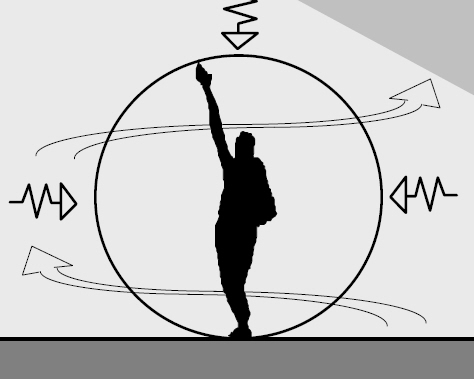Mean radiant temperature
All bodies exchange thermal radiation with their surroundings, depending on the difference in their surface temperatures and their emissivity. This radiant exchange is an important component of the thermal comfort that will be experienced by a person, particularly in places where there may be significant differences in radiant and air temperatures, for example, near a large window.
Other factors that influence thermal comfort include: environmental factors, such as air temperature, air velocity, relative humidity and the uniformity of conditions, as well as personal factors such as clothing, metabolic heat, acclimatisation, state of health, expectations, and even access to food and drink.
Mean radiant temperature (MRT) is a measure of the average temperature of the surfaces that surround a particular point, with which it will exchange thermal radiation. If the point is exposed to the outside, this may include the sky temperature and solar radiation.
The knowledge of surface geometries required to predict mean radiant temperature is very complex, particularly in elaborate spaces. However, mean radiant temperatures can be calculated by some proprietary software applications.
Mean radiant temperature can be measured using a globe thermometer. This is a hollow copper sphere painted matt black (to give it a high emissivity) with a temperature sensor at its centre.
From the temperature recorded, along with air velocity and air temperature (needed to account for convective heat exchange), the mean radiant temperature can be calculated:
MRT = globe temperature + 2.42 x air velocity in m/s (globe temperature – air temperature)
Note: This equation provides a very simplified rule of thumb. There are many different variations of this equation as it is dependent complex factors such as the size and emissivity of the globe thermometer. This particular example is taken from the Novalynx Corporation 2010, however, the units used in their equation appear to be incorrect, showing air velocity in cm/s rather than m/s. Thanks for pointing this out go to Dr Robert McLeod, Senior Lecturer Built Environment - Building Services Engineering, School of Environment and Technology at the University of Brighton.
[edit] Related articles on Designing Buildings Wiki
Featured articles and news
A change to adoptive architecture
Effects of global weather warming on architectural detailing, material choice and human interaction.
How big is the problem and what can we do to mitigate the effects?
Overheating guidance and tools for building designers
A number of cool guides to help with the heat.
The UK's Modern Industrial Strategy: A 10 year plan
Previous consultation criticism, current key elements and general support with some persisting reservations.
Building Safety Regulator reforms
New roles, new staff and a new fast track service pave the way for a single construction regulator.
Architectural Technologist CPDs and Communications
CIAT CPD… and how you can do it!
Cooling centres and cool spaces
Managing extreme heat in cities by directing the public to places for heat stress relief and water sources.
Winter gardens: A brief history and warm variations
Extending the season with glass in different forms and terms.
Restoring Great Yarmouth's Winter Gardens
Transforming one of the least sustainable constructions imaginable.
Construction Skills Mission Board launch sector drive
Newly formed government and industry collaboration set strategy for recruiting an additional 100,000 construction workers a year.
New Architects Code comes into effect in September 2025
ARB Architects Code of Conduct and Practice available with ongoing consultation regarding guidance.
Welsh Skills Body (Medr) launches ambitious plan
The new skills body brings together funding and regulation of tertiary education and research for the devolved nation.
Paul Gandy FCIOB announced as next CIOB President
Former Tilbury Douglas CEO takes helm.
UK Infrastructure: A 10 Year Strategy. In brief with reactions
With the National Infrastructure and Service Transformation Authority (NISTA).
Ebenezer Howard: inventor of the garden city. Book review.
Airtightness Topic Guide BSRIA TG 27/2025
Explaining the basics of airtightness, what it is, why it's important, when it's required and how it's carried out.























Comments